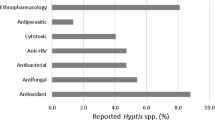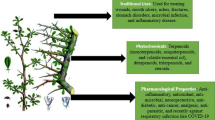Abstract
Warburgia ugandensis (W. ugandensis) is known by various names, including the East African greenheart, pepper bark tree, and Ugandan greenheart, and has a rich history of extensive use in the treatment of a host of human diseases in many African countries. This review is based on the botany and ethnopharmacological potentials of W. ugandensis for the treatment of pneumonia, asthma, malaria, candidiasis, skin infections, human immunodeficiency virus opportunistic infections, diarrhea, and measles given the common use in the management of these diseases. Extracts from W. ugandensis have strong antimicrobial activities against a broad spectrum of pathogens mainly because of the presence of abundant terpenoids, drimane, and coloratane type sesquditerpenoids amongst which are ugandensial, warburganal, mukaadial, and other secondary metabolites, such as tannins, flavonoids, saponins, steroids, and mannitol. This group of compounds gives the plant a high therapeutic value. Based on the review, there is a need for identification and isolation of the highly therapeutic phytochemical constituents and a drive for more preclinical and clinical trials to validate the safety and efficacy of the extracts. This gives basis for the potential development of new therapeutic drugs from the plant.
Similar content being viewed by others
References
Mwitari PG, Ayeka PA, Ondicho J, Matu EN, Bii CC. Antimicrobial activity and probable mechanisms of action of medicinal plants of Kenya: Withania somnifera, Warbugia ugandensis, Prunus africana and Plectrunthus barbatus. PLoS One 2013;8:e65619.
Orwa C, Mutua A, Kindt R. Agroforestree database: a tree reference and selection guide version 4.0, 2009. Available at: http://www.worldagroforestry.org.
Okello D, Komakech R, Matsabisa MG, Kang YM. A review on the botanical aspects, phytochemical contents and pharmacological activities of Warburgia ugandensis. J Med Plants Res 2018;12:448–455.
Lovett JC, Lovett J, Sørensen L. Field guide to the moist forest trees of Tanzania. London, UK: Society for Environmental Exploration, 2006.
Kiringe JW. A survey of traditional health remedies used by the Maasai of southern Kajiado District, Kenya. Ethnobotany Res Appl 2006;4:61–74.
Kokwaro JO. Medicinal plants of East Africa. Nairobi, Kenya: East African Literature Bureau, 2009.
Abuto JO, Morono DA. Interaction effects of site, samples, plant parts and solvent types on antimicrobial activity of the Kenyan populations of Warburgia ugandensis (Sprague). J Pharm Chem Biol Sci 2018;6:1–12.
Frum Y, Viljoen AM, Drewes SE. In vitro 5-lipoxygenase and antioxidant activities of Warburgia salutaris and drimane sesquiterpenoids. South Afr J Botany 2005;71:447–449.
Maobe MAG, Nyarango RM. Fourier transformer infrared spectrophotometer analysis of Warburgia ugandensis medicinal herb used for the treatment of diabetes, malaria and pneumonia in Kisii region, Southwest Kenya. Global J Pharmacol 2013;7:61–68.
Ekpo E, Pretorius E. Asthma, Euphorbia hirta and its anti-inflammatory properties. South Afr J Sci 2007;103:201–203.
El-Kamali HH, El-Khalifa KF. Treatment of malaria through herbal drugs in the Central Sudan. Fitoterapia 1997;6:527–528.
Nanyingi M, Mbaria J, Lanyasunya A. Ethnopharmacological survey of Samburu district, Kenya. J Ethnobiol Ethnomed 2008;4:14.
Wube AA, Bucar F, Gibbons S, Asres K. Sesquiterpenes from Warburgia ugandensis and their antimicrobial activity. Phytochemistry 2005;66:2309–2315.
Rukanga GM, Kofi-Tsekpo MW, Kurokawa M, Kageyama S, Mungai GM, Muli JM, et al. Evaluation of the HIV-1 reverse transcriptase inhibitory properties of extracts from some medicinal plants in Kenya. Afr J Health Sci 2002;9:81–90.
Lemanske Jr RF, Busse WW. Asthma: Clinical expression and molecular mechanisms. J Allergy Clin Immunol 2010;125:S95–S102.
Ngure PK, Tonui WK, Ingonga J, Mutai C, Kigondu E, Ng’ang’a Z, et al. In vitro antileishmanial activity of extracts of Warburgia ugandensis (Canellaceae), a Kenyan medicinal plant. J Med Plants Res 2009;3:61–66.
Kuglerova M, Tesarova H, Grade TJ, Halamova K, Wanyana-Maganyi O, Dame van P. Antimicrobial and antioxidant effects of Ugandan medicinal barks. Afr J Biotechnol 2011;10:3628–3632.
Were PS, Waudo W, Ozwara HS, Kutima HL. Phytochemical analysis of Warburgia ugandensis sprague using fourier transform infra-red (FT-IR) spectroscopy. Intern J Pharm Phytochem Res 2015;7:201–205.
World Health Organization. Traditional medicine strategy 2002–2005. Available at: http://www.who.int/medicines/library/trm/trm_strat_eng.pdf, 2002.
Lovett J, Clarke GP. Warburgia ugandensis ssp. longifolia. The IUCN Red list of threatened species, 1998, e.T32874A9730711. Available at: https://doi.org/10.2305/IUCN.UK.1998.
Dharani N, ed. Field guide to common trees and shrubs of East Africa. Penguin Random House South Africa, 2002:184.
Leonard CM, Viljoen AM. Warburgia: a comprehensive review of the botany, traditional uses and phytochemistry. J Ethnopharm 2015;165:260–285.
Beentje H, Adamson J, Bhanderi D, eds. Kenya trees, shrubs, and lianas. National Museums of Kenya, 1994:112.
Komakech R, Kang Y, Lee JH, Omujal F. A review of the potential of phytochemicals from Prunus africana (Hook f.) Kalkman stem bark for chemoprevention and chemotherapy of prostate cancer. Evidence-Based Complement Altern Med 2017;2017:3014019.
World Health Organization. World Malaria Report 2017. Available at: https://www.who.int/malaria/publications/world-malaria-report-2017/report/en/.
Njoroge GN, Bussmann RW. Diversity and utilization of antimalarial ethnophytotherapeutic remedies among Kikuyus (Central Kenya). J Ethn Ethnomed 2006;2:8.
Taniguchi M, Chapya A, Kubo I, Nakanishi K. Screening of East African plants for antimicrobial activity 1. Chemical Pharm Bull 1978;26:2910–2913.
Nanyingi MO, Kipsengeret KB, Wagate CG. In vitro and in vivo antiplasmodial activity of Kenyan medicinal plants. Ethnic Groups 2010;16:17.
Maroyi A. The genus Warburgia: a review of its traditional uses and pharmacology. Pharm Bio 2013;52:378–391.
Manolakaki D, Velmahos G, Kourkoumpetis T, Chang Y, Alam HB, De Moya MM, et al. Candida infection and colonisation among trauma patients. Virulence 2010;1:367–375.
Kourkoumpetis TK, Velmahos GC, Ziakas PD, Tampakakis E, Manolakaki D, Coleman JJ, et al. The effect of cumulative length of hospital stay on the antifungal resistance of Candida strains isolated from critically ill surgical patients. Mycopathologia 2011;171:85–91.
Ahmed M, Laing M, Nsahlai IV. In vitro antihelmintic activity of crude extracts of selected medicinal plants against Haemonchus contortus from sheep. J Helminthol 2013;87:174–179.
Olila D, Opuda AJ, Olwa-Odyek. Bioassay-guided studies on the cytotoxic and in vitro trypanocidal activities of sesquiterpene (muzigadial) derived from a Ugandan medicinal plant (Warburgia ugandensis). Afr Health Sci 2001;1:121–115.
Merawie Y, Sahile S, Moges F, Husen A. Antimicrobial activity of crude and semi-purified fractions of Warburgia ugandensis against some pathogens. J Coast Life Med 2013;1:184–191.
World Health Organization. Recommendations on the management of diarrhoea and pneumonia in HIV-infected infants and children. Available at: https://www.unicef.org/aids/files/hiv_diarrhoea_and_pneumonia.pdf, 2010.
Tintinalli EJ, Stapczynski SJ, Ma JO, Yealy D, Meckler GD, Cline DM. Emergency medicine: a comprehensive study guide. 8th ed. New York: McGraw-Hill, 2015.
Maobe MAG, Gitu L, Gatebe E, Rotich H. Phytochemical analysis of phenol and flavonoid in eight selected medicinal herbs used for the treatment of diabetes, malaria and pneumonia in Kisii, Kenya. Acad J Cancer Res 2012;5:31–39.
Bele AA, Jadhav VM, Kadam VJ. Potential of tannins: a review. Asian J Plants Sci 2010;9:209–214.
Tong SY, Davis JS, Eichenberger E, Holland TL, Fowler Jr VG. Staphylococcus aureus infections: epidemiology, pathophysiology, clinical manifestations, and management. Clin Microbiol Rev 2015;28:603–661.
Curran JP, Al-Salihi FL. Neonatal staphylococcal scalded skin syndrome: massive outbreak due to an unusual phage type. Pediatrics 1980;66:285–290.
Nakatsuji T, Chen TH, Two AM, Chun KA, Narala S, Geha RS, et al. Staphylococcus aureus exploits epidermal barrier defects in atopic dermatitis to trigger cytokine expression. J Invest Dermatol 2016;136:2192–2200.
Geyid A, Abebe D, Debella A, Makonnen Z, Aberra F, Teka F, et al. Screening of some medicinal plants of Ethiopia for their anti-microbial properties and chemical profiles. J Ethnopharm 2005;97:421–427.
Morrissey JP, Osbourn AE. Fungal resistance to plant antibiotics as a mechanism of pathogenesis. Microbiol Mol Biol Rev 1999;63:708–724.
Cohen BE, Durstenfeld A, Roehm PC. Viral causes of hearing loss: a review for hearing health professionals. Trends Hearing 2014;2331216514541361.
Kabra SK, Lodhra R. Antibiotics for preventing complications in children with measles. Cochrane Data System Rev 2013;8:CD001477.
Olila D, Olwa-Odyek, Opuda AJ. Antibacterial and antifungal activities of extracts of Zanthoxylum chalybeum and Warburgia ugandensis, Ugandan medicinal plants. Afr Health Sci 2001;1:66–72.
Martinez FD. Genes, environments, development and asthma: are appraisal. Eur Respir J 2007;29:179–184.
Jennette CJ, Falk RJ, Bacon PA, Basu N, Cid MC, Ferrario F, et al. 2012 Revised International Chapel Hill Consensus Conference nomenclature of vasculitides. Arthritis Rheum 2013;65:1–11.
GBD. 2015 Disease and injury incidence and prevalence, collaborators. global, regional, and national incidence, prevalence, and years lived with disability for 310 diseases and injuries, 1990-2015: a systematic analysis for the Global Burden of Disease Study 2015. Lancet 2016;388:1545–1602.
Karani LW, Tolo FM, Karanja SM, Khayeka-Wandabwa C. Safety of Prunus africana and Warburgia ugandensis in asthma treatment. South Afr J Botany 2013;88:183–190.
Kisangau DP, Lyaruu HV, Hosea KM, Joseph CC. Use of traditional medicines in the management of HIV/AIDS opportunistic infections in Tanzania: a case in the Bukoba rural district. J Ethnobiol Ethnomed 2007;3:29.
Girum T, Wasie A, Lentiro K, Muktar E, Shumbej T, Difer M, et al. Gender disparity in epidemiological trend of HIV/ AIDS infection and treatment in Ethiopia. Arch Pub Health 2018;76:51.
van Delden C, Iglewski BH. Cell-to-cell signaling and Pseudomonas aeruginosa infections. Emerg Infect Dis 1998;4:551–560.
Bessong PO, Obi CL, Andréola ML, Rojas LB, Pouységu L, Igumbor E, et al. Evaluation of selected South African medicinal plants for inhibitory properties against human immunodeficiency virus type 1 reverse transcriptase and integrase. J Ethnopharm 2005;99:83–91.
Asiimwe S, Mugisha KM, Namutebi A, Borg-Karlsson AK, Musiimenta P. Ethnobotanical study of nutri-medicinal plants used for the management of HIV/AIDS opportunistic ailments among the local communities of western Uganda. J Ethnopharmacol 2013;150:639–648.
Mbwambo ZH, Erasto P, Innocent E, Masimba PJ. Antimicrobial and cytotoxic activities of fresh leaf extracts of Warburgia ugandensis. Tanzania J Health Res 2009;11:75–78.
Pasetto S, Pardi V, Murata RM. Anti-HIV-1 activity of flavonoid myricetin on HIV-1 infection in a dual-chamber in vitro model. PloS One 2014;9:e115323.
Chung KT, Wei CI, Johnson MG. Are tannins a double-edged sword in biology and health? Trends Food Sci Tech 1998;4:168–175.
Wamalwa NL, Oballa P, Gicheru J. Genetic variation of Warburgia ugandensis in Kenya and implications for its cultivation. Kenya Forestry Research Institution (KEFRI), Nairobi, 2006.
Author information
Authors and Affiliations
Contributions
Okello D carried out the data search and was the main contributor in writing the manuscript. Kang Y technically designed and helped in writing the manuscript. Both authors read and approved the final manuscript.
Corresponding author
Ethics declarations
The authors declare that there is no conflict of interests regarding the publication of this paper.
Additional information
Supported by the Framework of International Cooperation Program (Korea-South Africa Cooperative Research Project for Excavation of Candidate Resources of Complementary and Alternative Medicine) managed by National Research Foundation of Korea [No. 2017093655, Korea Institute of Oriental Medicine (KIOM): D17470], Development of Foundational Techniques for the Domestic Production of Herbal Medicines (No. K18405) and Applicational Development of Standardized Herbal Resources (KSN1911420) from KIOM, through the Ministry of Science and ICT, Republic of Korea
Electronic supplementary material
11655_2019_3042_MOESM1_ESM.pdf
Appendix 1. Names and Molecular Structures of Compounds in different Parts of W. ugandensis (Okello, et al(3) Leonard and Viljoen(22))
Rights and permissions
About this article
Cite this article
Okello, D., Kang, Y. Ethnopharmacological Potentials of Warburgia ugandensis on Antimicrobial Activities. Chin. J. Integr. Med. 27, 633–640 (2021). https://doi.org/10.1007/s11655-019-3042-6
Accepted:
Published:
Issue Date:
DOI: https://doi.org/10.1007/s11655-019-3042-6




